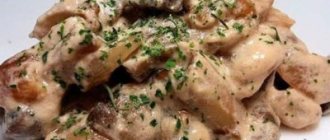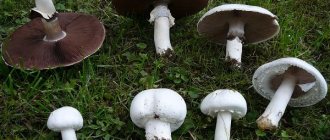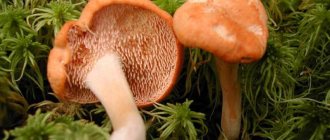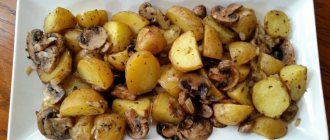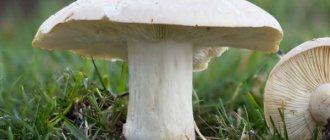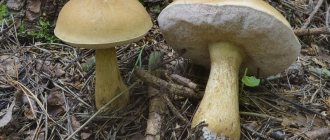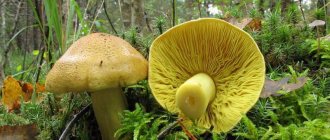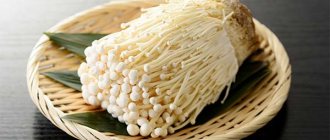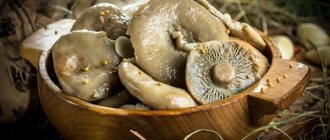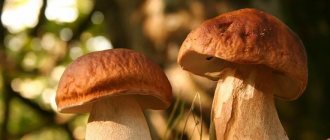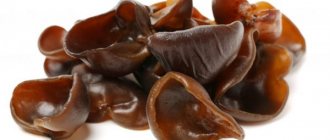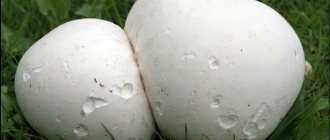Basidiomycota is a division of higher fungi in which the vegetative body is represented by branched cellular mycelium. Vegetative cells are haploid or dikaryonic, and the dikaryonic stage predominates in duration. The sexual process is somatogamy. Sexual sporulation is basidium with basidiospores. The monadic stage is completely absent.
The department has about 30,000 species and is the second largest in the number of species after the Ascomycotidae. The evolution of basidiomycots occurred in parallel with ascomycots. The department includes almost all ecological groups of fungi, including saprotrophs on various substrates, parasites of higher plants, mycorrhizal fungi, wood-ruining fungi, etc. There are also coprotrophs and mycotrophs. Among the basidiomycetes, many species are classified as edible or poisonous mushrooms. Some representatives have valuable medicinal properties.
Biochemical features and nutrition
Basidiomycota synthesize lysine via the fungal route (AAA pathway). Tryptophan synthesis occurs in different ways - in cap mushrooms from rotting fruiting bodies it is synthesized using the second complex of enzymes, in all others - using the fourth complex. Iron ions are absorbed with the help of green manure. Polyols (including mannitol) are available in fairly large quantities. Consumption of organic substances occurs exclusively through absorption. Many basidiomycotes have powerful exoenzyme systems, with the help of which cellulose and lignin (cellulase, peroxidases, oxidases), proteins (various peptidases), and fats (lipases) are hydrolyzed outside the cells. The source of carbon and nitrogen are various organic compounds. The metabolism of steroids is regulated by mycosporins, which in many basidiomycotes are capable of initiating the sexual process. Fungi of this division are characterized by a wide range of secondary metabolites, which include antibiotics, mycotoxins, growth inhibitors of higher plants, phytohormones, etc.
Beneficial features
The mushroom is considered a delicacy and is used in dietetics. It includes the following elements:
- vitamin E;
- vitamin PP;
- group B;
- iron, potassium, phosphorus, zinc;
- campesterol (natural antibiotic);
- amino acids and much more.
The calorie content of royal champignon per 100 g of product is only 25–27 kcal. It contains about 3% crude fat and 45% protein.
Beneficial features:
- eliminates migraine, headache;
- relieves fatigue;
- improves skin structure;
- promotes weight loss;
- destroys viruses and bacteria:
- suppresses cancer cells;
- disinfects;
- reduces blood sugar and cholesterol levels;
- has an immunostimulating effect;
- used for paratyphoid and typhus;
- improves the digestibility of food and nutrients;
- speeds up metabolism.
Pharmaceutical extracts from champignon juice are used to prepare drugs against hypertension, dyspepsia and allergies.
Cytological features
The cells of basidiomycotes are covered with membranes, the basis of which is chitin and glucans. The shells, unlike ascomycotes, are multilayered. The septa between the cells are simple or doliporous with an open pore (in ostomycetes), simple with time, closed by small vacuoles (theliomycetes) or doliporous with a parentosome (basidiomycetes). The parentosome can be continuous and not have perforation, be perforated, or consist of numerous fragments-vesicles (this feature is used when dividing basidiomycetes into orders).
Nuclear apparatus of eukaryotes. Mycelium, developing from basidiospores, has cells predominantly with one nucleus, and exists only for a short time. The predominant stage in the development cycle is the dikaryonic septate mycelium, where pairs of nuclei are formed during the sexual process due to plasmogamy, which is not immediately accompanied by karyogamy.
Mitosis is open (in cap mushrooms) or closed (in all others), centrioles are absent, and the centers of microtubule organization, like ascomycots, are polar accumulations of amorphous nucleoproteins. At the beginning of mitosis, the nucleolus is predominantly disintegrated, less often it is pushed into the cytoplasm, where it is stored until the beginning or completion of telophase.
Mitochondria with plasticity cristae. The Golgi complex is absent. Single-membrane organelles similar to ascomycotes are analytical vesicles, chitosomes, lomasomes, microbodies, and vacuoles with cell sap. The most common types of inclusions are oil droplets and glycogen globules. Flagellar stages are completely absent.
Similar species
Representatives of the champignon genus are generally quite similar to each other.
Most similar to bisporus champignon:
- Esset champignon.
It grows in the wild, usually in forests dominated by coniferous trees. It differs in appearance in that it has a rather thin leg, on which is located a fragmented ring of a private bedspread. This species is edible and has good taste.
- Crooked champignon.
It grows in the same conditions as the Esset champignon. It is edible, but in appearance it is extremely similar to the white toadstool (it differs from it in the pronounced aroma of anise).
1-Champignon Esset. 2-Champignon crooked.
- Bernard's champignon.
Not as tasty as the representatives described above, it belongs to the conditionally edible category. This champignon has a pinkish-white color and a thin remnant of velum on the stem.
- Yellow-skinned champignon (poisonous).
It is similar to an ordinary wild champignon, but its difference is that when mechanically applied to the cap, a yellow spot is formed. In addition, the ring on the stem is double-layered.
1-Bernard's champignon. 2-Yellow-skinned champignon.
Variegated champignon.Meller's champignon (variegated).
It has a gray-white cap with darker gray or brown scaly growths. The stem of this mushroom is white (when young), then turns yellow to brownish in color.
Grows in park areas on alkaline soils. The mushroom belongs to the category of poisonous.
Some similar types of champignons have poisonous properties, so bisporus champignon is much safer to obtain in artificially created conditions than to collect wild specimens. In addition, artificially grown champignons have much better nutritional properties.
Vegetative body
Represented by haploid (short stage of the life cycle) and dikaryonic (main stage of the life cycle) mycelium. The mycelium developing from sexually sporulated spores - basidiospores - is haploid, and is often formed by cells, capable of budding, as a result of which it may have a pseudomycelial habit. The predominant type of vegetative body in the development cycle is dikaryonic mycelium, which develops after the sexual process. Such mycelium is usually abundantly branched, multicellular and septate.
In most basidiomycots, the dikaryonic mycelium has buckles - special arcuate cells located at the transverse septum of the hyphae and connect its two cells. The buckle is homologous to the hook of ascogenous hyphae and performs the function of restoring cell binucleality. The presence of buckles on the mycelium is a stable feature for groups of different ranks - from order to species (for example, buckles are absent in representatives of the orders Uredinales and Russulales, and many species of the genus Tricholoma).
The most famous modification of the mycelium in Basidiomcataceae is the fruiting body. Unlike ascomycots, they are formed exclusively by hyphae of dikaryonic mycelium. Other modifications include rhizomorphs - strands of tightly intertwined hyphae, with the help of which the mycelium is able to quickly move in space.
Description
hat
The size ranges from 5 to 15, sometimes up to 20 centimeters. The shape of the cap is in the shape of a hemisphere, closed, over time it straightens out and becomes convex-spread. At the edges of the cap, fragments of the membranous blanket that covered the hymenophore (spore-bearing layer) are visible.
The color of the skin is yellowish or golden in hue, there are matte brown scales over the entire surface, orange-brown in youth, towards the center of the cap they become more frequent and almost completely cover the skin. A mature mushroom often has a clearly visible tubercle in the center of the cap.
Spore-bearing layer
Lamellar. The young fungus is covered with a filmy blanket, which creates a favorable environment for the maturation of spores. Subsequently, the film breaks, hanging in fragments on the edges of the cap and forming a characteristic filmy ring on the stem.
The plates are often located, freely, at the beginning of the growth of the champignon they have a white-cream color, gradually darkening to brown with a chocolate tint. The spore powder is also brown in color.
Leg
The thickness of the leg is about 2, occasionally 3 centimeters, quite long, about 10-15 centimeters. The surface of the leg is rough, scaly, white or yellowish-grayish in color, with a slight thickening at the base. When pressed, the flesh of the leg turns slightly yellow, oxidizing in the air.
Pulp
Dense, quite elastic, more brittle in the cap, hardening in the stem as the mushroom ages. The aroma is described in different ways, some consider it similar to the smell of anise seed, some compare it to calamus root, others - with an almond smell. The taste of the pulp is slightly pungent, mushroomy, and pleasant. When broken or cut, the flesh becomes pink or reddish in color.
Reproduction
The main method of reproduction of basidiomycotes is reproduction using sexual sporulation spores - basidiospores. To a lesser extent, they are represented in vegetative reproduction - by parts of the mycelium and single specialized cells that are formed as a result of fragmentation of hyphae - telytospores, Uredospores or resting akinetic thick-walled cells - chlamydospores. Asexual reproduction using conidia is much less common.
Sexual reproduction
Unlike ascomycotic fungi, basidiomycetes lack differentiated reproductive organs. The sexual process is somatogamy. It occurs either by the fusion of two vegetative cells of haploid mycelium or two basidiospores or their budding products. The cells involved in copulation predominantly have different sex signs: “+” and “-”. In some species, the sexual process occurs through copulation of basidiospores or their budding products. After plasmogamy, the nuclei unite into a dikaryon, which subsequently divide synchronously, forming a dikaryontic mycelium. Such mycelium can exist for a long time, and is the predominant stage of the life cycle of basidiomycots. From dikaryonic cells, sexual sporulation develops - basidium with basidiospores.
Preparation
Two-spore champignon is used for frying, boiling, stewing, pickling, canning, but it is allowed to eat it even raw (in very limited quantities). It belongs to food category 2 and has a pleasant taste and aroma.
Before using in culinary dishes, mushrooms must be properly prepared:
- Remove dirt with a brush or cloth.
- Cut off 2–3 mm of the stems. If there is damage or rotten areas, remove them with a knife.
- Rinse under running water.
- Dry on a paper or cloth towel.
If you were able to collect only very old champignons, be sure to remove the film from the stem and cap.
Cooking and frying rules that should be strictly followed:
- cook for about 7–10 minutes, then let the water drain, otherwise it will greatly saturate the structure of the mushroom;
- You need to fry the raw product for no more than 15 minutes and 5 minutes if it is already cooked.
Life cycle and development of sexual sporulation
In its most general form, the life cycle of basidiomycots includes the following stages: a haploid mycelium develops from a haploid basidiospore. Its cells copulate, while plasmogamy occurs, karyogamy is not accompanied, and a dikarynthic fusion cell is formed. From it, dikaryontic mycelium develops, which is the main vegetative generation of basidiomycots. Individual dikaryontic cells develop in basidia: in them, the dikaryon nuclei fuse (karyogamy), meiosis occurs, and haploid basidiospores are formed on the basidium. Thus, the life cycle of haplophasics, with zygotic reduction and heteromorphic alternation of generations - haploid and dikaryonic mycelium, with the dikaryonic phase being predominant. In some fungi (for example, irjastiha), the dikaryonic phase can form additional non-sexual sporulation - ecidiospores (spring spores), uredospores (summer spores), telytospores (winter spores), or develop conidial sporulation.
Basidium development
Two main variants of the development of basidia are known: from single resting cells - telytospores and from the apical cells of the hyphae of dikaryonic mycelium (mainly according to the buckle method). During the development of basidia from the telytospore, its dikaryonic nuclei merge, a diploid basidium grows from the telytospore, then meiosis occurs in it and the shell forms protrusions - sterigmata, each of which includes one haploid nucleus of the cytoplasm. The sterigmami are separated from the basidia by septa, grow at the apex and transform into mononuclear haploid basidiospores. During the development from dikaryonic hyphae of the mycelium to the basidium, the apical dikaryonic cells of such hyphae transform from the shell of the apical cell of the hyphae, a small lateral outgrowth extends - a buckle, which bends downwards. At the same time, dikaryon nuclei divide, and four nuclei are formed in the cell. Two nuclei of different sexes are directed to the top of the hypha, the third nucleus moves to the base of the cell, and the fourth enters the buckle outgrowth. Simultaneously with the separation of the nuclei, the cell itself is divided, two partitions are formed - one separates the buckle, the second divides the cell in half. Thus, three cells are formed: the upper one, which contains two nuclei of opposite sexes, the lower cell with one nucleus, and the outgrowth or buckle cell, which also contains one nucleus of the opposite sex sign. Subsequently, the outgrowth of the buckle grows to the wall of the lower cell and through the hole the nucleus migrates into this cell, restoring its binucleate or dikaryontic state. The basidium is formed from the upper cell with two heterosexual nuclei. This cell gradually grows, karyogamy occurs in it and a diploid nucleus is formed. It almost immediately undergoes reduction division, forming four haploid nuclei. The shell of the future basidia develops protrusions - sterigmata. Each sterigma contains part of the cytoplasm of the basidia and one nucleus. Gradually growing, the tips of the sterigmata swell and turn into basidiospores. Thus, in both variants, basidiospores develop exogenously, in contrast to ascospores, which are formed endogenously. Basidia can be solitary (if they develop from telytospores), or formed on the hyphae of developed dikaryonic mycelium, forming the basis of the hymenium. The hymenium is a layer of basidium with basidiospores and sterile protective elements. The sterile elements formed in the hymenial layer are represented, first of all, by paraphyses (they separate the basidium from each other and prevent the basidiospores from sticking together) and cystidams (they protect the hymenial layer from pressure from above). Occasionally, the hymenium develops on vegetative mycelium (in particular, in exobasidial fungi), but in most cases it forms on the surface or inside the fruiting bodies. The presence of fruiting bodies is the main characteristic of the class Basidiomycetes.
Types of basidia
Based on the morphological structure, basidia are divided into unicellular ones - holobasidia, and into basidia with septa - phragmobasidia. The septa in the phragmobasidium can be longitudinal or transverse. Phragmobasidia with longitudinal septa are usually divided into four cells by septa (this structure is typical for tremmel fungi). Options with transverse septa are more diverse: in some orders the basidia has only one septa, and is divided into two cells - the upper epibasidium and the lower hypobasidium. In auricularial fungi and many smut and irradius fungi, the number of transverse septa is three, that is, the basidium consists of four cells located one above the other. Based on the nature of the location of the spindle during meiosis (phase mitosis I) and the levels of arrangement of nuclei after the second division (phase mitosis II), the basidia are divided into chiastic and static. In chiastic basidia, during meiosis, the diploid nucleus is located at the apex of the basidia, the spindle is oriented perpendicular to the longitudinal axis of the basidia. As a consequence, after the second division (phase mitosis II), all four haploid nuclei are located at the apex of the basidium at approximately the same level. In stichic basidia, during meiosis the nucleus is located approximately in the center of the basidia, and the spindle is oriented parallel to its longitudinal axis. As a consequence, after the second section, the daughter haploid nuclei are located in the basidium at different levels.
Types of basidiospores
Although all basidiospores are formed exogenously and have one haploid nucleus, they are quite diverse in many morphological characteristics (in particular, shape, color, size, shell surface, in the presence of time seedlings, etc.). The leading characteristics of basidiospores used in dividing basidiomycota into taxa of high and middle ranks (in particular, orders and families) include their ability to actively separate from basidia and be stained with certain dyes, primarily those containing iodine. Basidiospores are actively fired from basidia and are called balistospores. Such shooting is associated with the formation of a vacuole in the sterigmata, where glycogen is hydrolyzed to simple sugars, and as a result, high turgor pressure develops. Based on their ability to stain with Lugol's solution or Meltzer's reagent, basidiospores are divided into amyloid and non-amyloid. Amyloid spores contain soluble starch, which with iodine gives a dirty purple color.
Interesting Facts
- The history of champignon cultivation dates back to the 17th century (at least, the first mentions of it date back to this century). The Italians and French were the first to specifically grow champignons (in garden beds and abandoned quarries). By the middle of the 18th century, Russia also became interested in growing champignons.
- At first it was believed that the cultivated champignon was the closest relative of the wild Champignon, but later the bisporous champignon was described as a separate species. They also tried to grow other species, but the bisporus champignon grows best on manure.
Eating cultivated champignons is much safer than wild ones, since there is no risk of eating a poisonous species and confusing it with an edible one. However, there are contraindications for edible mushrooms: allergies to this product, childhood (immaturity of the gastrointestinal tract) and diseases of the digestive system.
Common champignon (Agaricus campestris)
- Other names for the mushroom:
- Real champignon
- Meadow champignon
- Pecheritsa
Synonyms:
Description: The cap of a common champignon with a diameter of 8-10 (15) cm, at first spherical, semi-spherical, with a rolled edge and a private blanket covering the plates, then convex-prostrate, prostrate, dry, silky, sometimes finely scaly in maturity, with brownish scales in the middle, with remnants of a veil along the edge, white, later slightly brownish, slightly pinkish in wounded areas (or does not change color).
The plates are frequent, thin, wide, loose, at first white, then noticeably pink, later darkening to brown-red and dark brown with a violet tint.
The spore powder is dark brown, almost black.
The common champignon has a stem 3-10 cm long and 1-2 cm in diameter, cylindrical, smooth, sometimes narrowed towards the base or thickened, solid, fibrous, smooth, light, single-colored with a cap, sometimes brownish at the base, rusty. The ring is thin, wide, sometimes located lower than usual, towards the middle of the leg, often disappearing with age, white.
The pulp is dense, fleshy, with a pleasant mushroom smell, white, slightly pink when cut, then reddening.
Distribution: Common champignon grows from the very end of May to the end of September in open spaces with rich humus soils, especially after rains, in meadows, pastures, in gardens, vegetable gardens, parks, near farms, on cultivated lands, near housing, on the streets, in grass, less often on the edges of the forest, in groups, rings, often, annually. Widely spread.
Similarity: If a common champignon grows near a forest, then it (especially young specimens) can easily be confused with the pale toadstool and the white fly agaric, although their plates are only white, not pink, and there is a tuber at the base of the stem. Still similar to the common champignon, the red champignon is also poisonous.
Video about the common champignon mushroom:
Rating: Common champignon is a tasty, healthy, edible mushroom (2 categories), used in a variety of ways, fresh (boiled for about 10 minutes) in first and second courses, salted, pickled. In terms of the content of proteins digestible by the human body, it is comparable to porcini mushroom.
Note: A valuable mushroom of excellent taste, suitable for all types of culinary processing.
Growing at home and in the country
The most common mushrooms have long been grown in greenhouses, basements and garden beds
It is very important for them to prepare high-quality compost:
- Take 6 kg of straw and 4 kg of manure.
- Place everything layer by layer in the prepared hole.
- Water every day and turn with a pitchfork once a week.
- After three weeks the compost is ready.
The time may vary depending on the raw materials and air temperature, but as soon as the ammonia smell disappears, the mixture can be used. Compost is spread on the beds.
It is better to purchase the mycelium itself from a responsible seller. When growing outdoors, you should choose the most shaded area:
- The soil is slightly fluffed up.
- Plants, grass, roots should be left, they will help the mycelium form.
- The surface is sprinkled with mycelium and covered with prepared compost.
- You need to water as needed.
The first harvest, as a rule, germinates after 2.5 months. Sowing can be done in spring, summer or autumn. In winter, the mycelium is covered with fallen leaves and pine needles.
